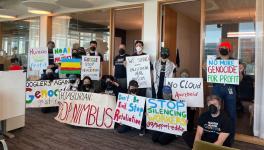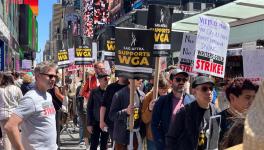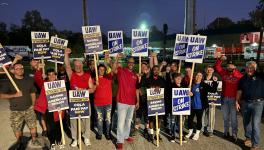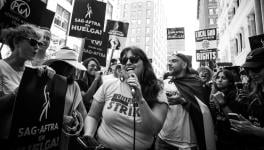Teamsters Win: Why is it Historic and What’s Next?
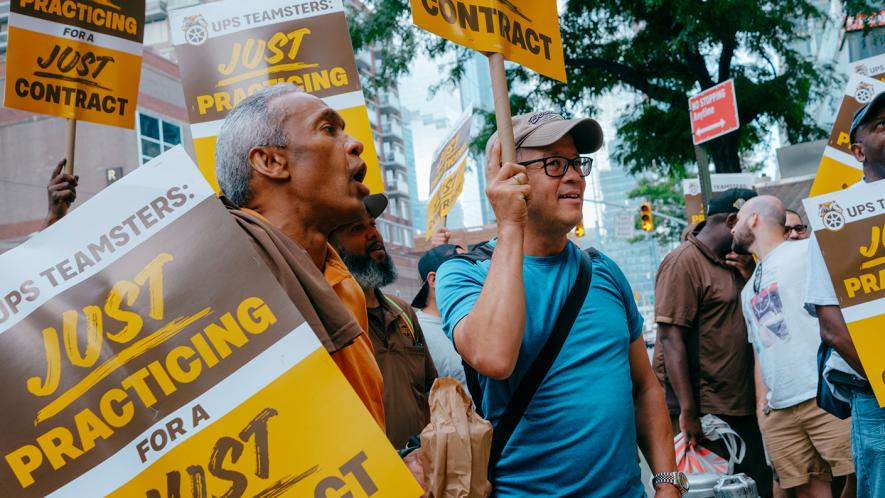
UPS Teamsters at a practice picket in Manhattan, New York (Photo: Wyatt Souers/Party for Socialism and Liberation)
On July 25, leaders in the International Brotherhood of Teamsters (IBT) announced that 340,000 UPS Teamsters had secured a tentative agreement with the United Parcel Service (UPS). This agreement, if ratified by union workers in August, would cement historic gains for the entire working class, including the expansion of full-time job opportunities and major improvements on wages.
UPS Teamsters put up a bold fight over the last few months to secure these victories. Despite UPS CEO Carol Tomé’s words about the TA being a “win-win” for both the company and the workers, no material gains were handed to workers out of the goodness of UPS’s heart. Instead, the highest echelons of the capitalist class, observing the practice pickets across the country, the 97% strike authorization vote, and nationwide solidarity, had obviously begun to show fear. On July 21, just three days before the TA was won, a US Chamber of Commerce-led coalition sent a letter to the Joe Biden administration, calling on the federal government to intervene in UPS contract negotiations to prevent a strike. “Given the debilitating impact of a strike on American families and the economy,” wrote the coalition, “we urge your Administration to provide the support necessary to help the parties reach a new agreement by the August 1 deadline.”
A historic contrast
To contextualize the significance of these gains, the previous national master agreement between Teamsters workers and UPS (the largest single employer contract in the US) was notably unpopular. In 2018, it was voted down by members of the union for its concessions to the company, including creating the two-tier 22.4 system in which some workers are paid less than others for the same labor. But the former Teamsters president, James P. Hoffa, used an obscure rule to force the agreement through anyways.
As Antonio Rosario, 29-year UPS Teamster in Local 804 and a part of the international steering committee for Teamsters for a Democratic Union (TDU) describes it, this was the “straw that broke the camel’s back” for the former Teamsters leadership.
Following the 2018 contract debacle, the current General President Sean O’Brien was able to join forces with TDU, a long-standing Teamsters reform organization, to unseat the old guard and bring a new fighting energy to union leadership. Before O’Brien’s slate was even elected to leadership, they spearheaded a successful push to eliminate the two-thirds rule.
It is this leadership that has led the fight resulting in a landmark TA for 340,000 workers. O’Brien has delivered on the issues he campaigned on: removing the 22.4 system, and creating an initiative to unionize Amazon. According to Rosario, the new leadership’s strategy was to identify the demands of the workers before coming to the bargaining table with the company. “The amount of surveys that went out to all the members listening to the workers…is amazing because this is exactly what we’re fighting for,” he said. “After [leadership] heard everything that all the members were complaining about, and compound[ed] all that information together, they came out with a strategic plan against UPS in contract negotiations, fighting for exactly what it was the members were asking for.”
“The first thing we did is we went out and talked to our members and listened to our rank and file members who have to work in these conditions,” said O’Brien during a Fox Business appearance post-TA.
New fighting leadership forwards competitive wins
In the current national master agreement, the wage for part-time workers can be as low as USD 15.50. UPS does not usually pay this low to attract new employees (called a market rate adjustment), but presently, the average starting wage is USD 16.50. Peoples Dispatch spoke to multiple part-time UPS workers in New York City who claimed to be paid as low as USD 16 per hour, worked multiple jobs to stay afloat, or who had coworkers who must resort to sleeping in shelters. In this latest TA, UPS Teamsters won a starting wage of USD 21 per hour.
Rosario told Peoples Dispatch about his first-hand experience with wage stagnation in the country since he started at UPS in 1994. “Believe it or not, even though my wage was only 9.50 dollars an hour, I was still making five bucks above minimum wage in ‘94,” he said. Rosario lost his father in 1992, and had to quit college to work to help his mother avoid foreclosure on their family home.
“I found a good union job, working at UPS part time, and I was able to make enough money to help my mom keep the house. And it’s one of my greatest achievements… these part-timers could never do that today at minimum wage.” Minimum wage in New York City is currently USD 15 per hour.
The future of Teamsters
The Teamsters are now taking on Amazon, organizing strikes of drivers and dispatchers across the country. Workers are striking in response to Amazon’s unfair labor practices and refusal to recognize the union or bargain with Teamsters regarding low pay and dangerous working conditions.
The Teamsters’ focus on the logistics sector is key. Amazon utilizes UPS to fulfill some of its deliveries; in fact, Amazon is UPS’s biggest customer. The Teamsters’ historic role in organizing logistics workers places it in a strategic position to strike against capitalism where it will hurt the most: in the daily transport of commodities. UPS Teamsters move 6% of the US GDP everyday, and 3% of the world’s GDP. Amazon leads in the nation’s e-commerce industry.
According to Randy Korgan, the director of the Teamsters Amazon Division, “Amazon poses an existential threat to the rights and standards that our members have fought for and won for over 100 years.”
Tom Culver, a striking driver from Palmdale, California, says, “We do the same job as other package delivery drivers, but Amazon pays us half as much.” Some call the Teamsters’ shift to taking on Amazon as a signal that the UPS fight was “a type of warmup.”
“It’s a labor movement,” says Rosario. “It’s not just about UPS. It’s about all these corporations being stood up against by the workers. And we’re going to be there as Teamsters. We’re going to try to support as many of them as we can.”
Get the latest reports & analysis with people's perspective on Protests, movements & deep analytical videos, discussions of the current affairs in your Telegram app. Subscribe to NewsClick's Telegram channel & get Real-Time updates on stories, as they get published on our website.









